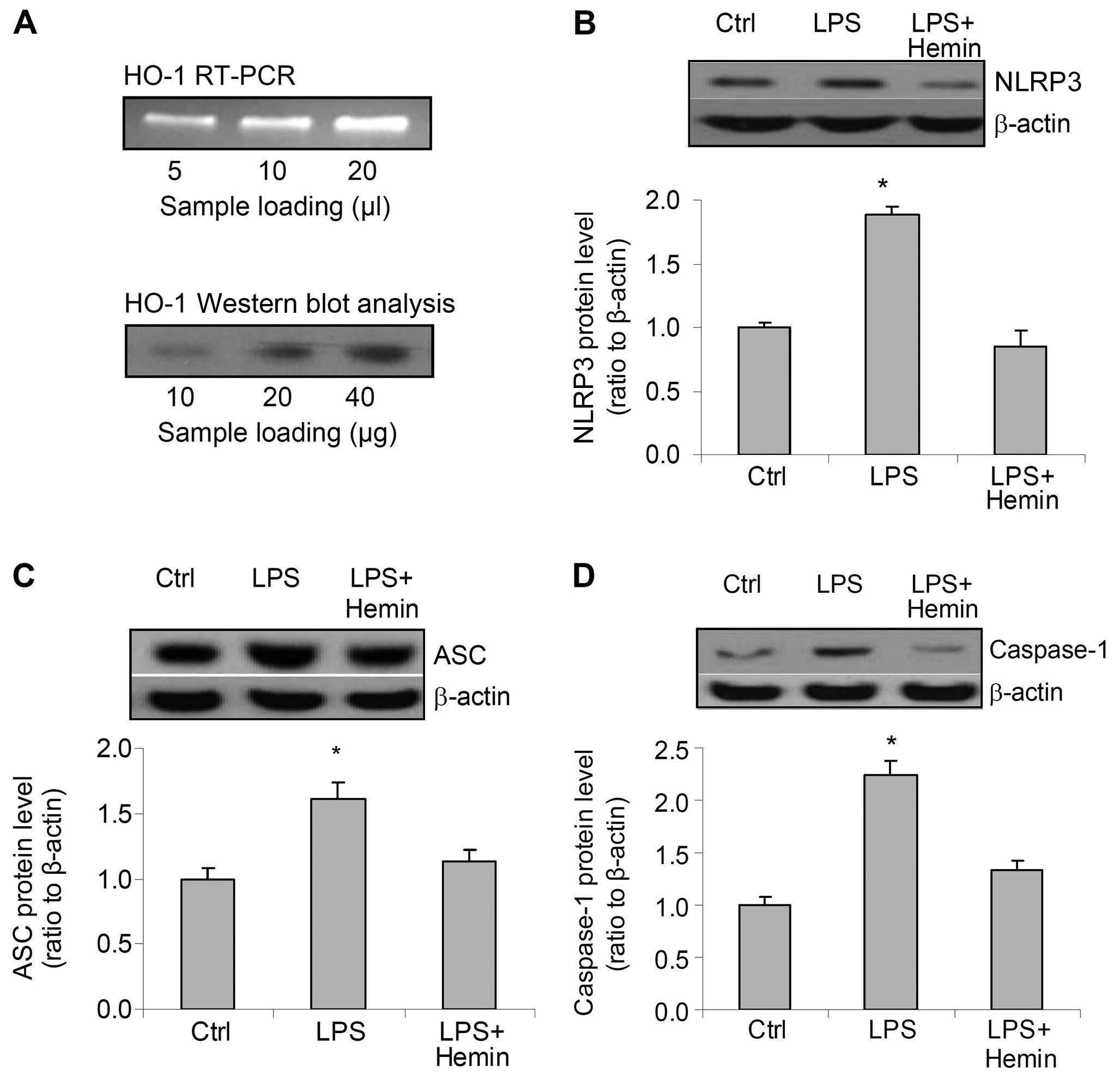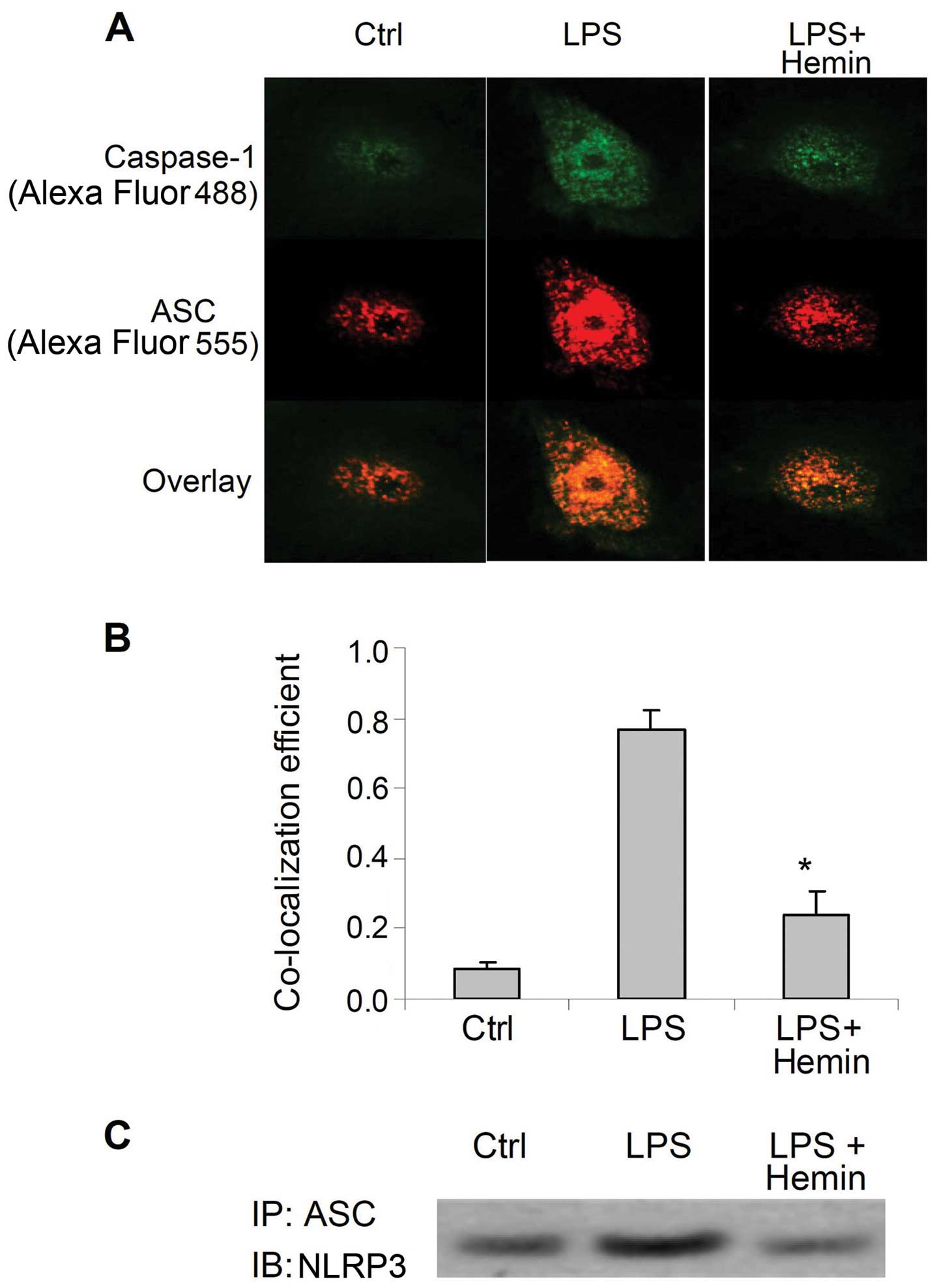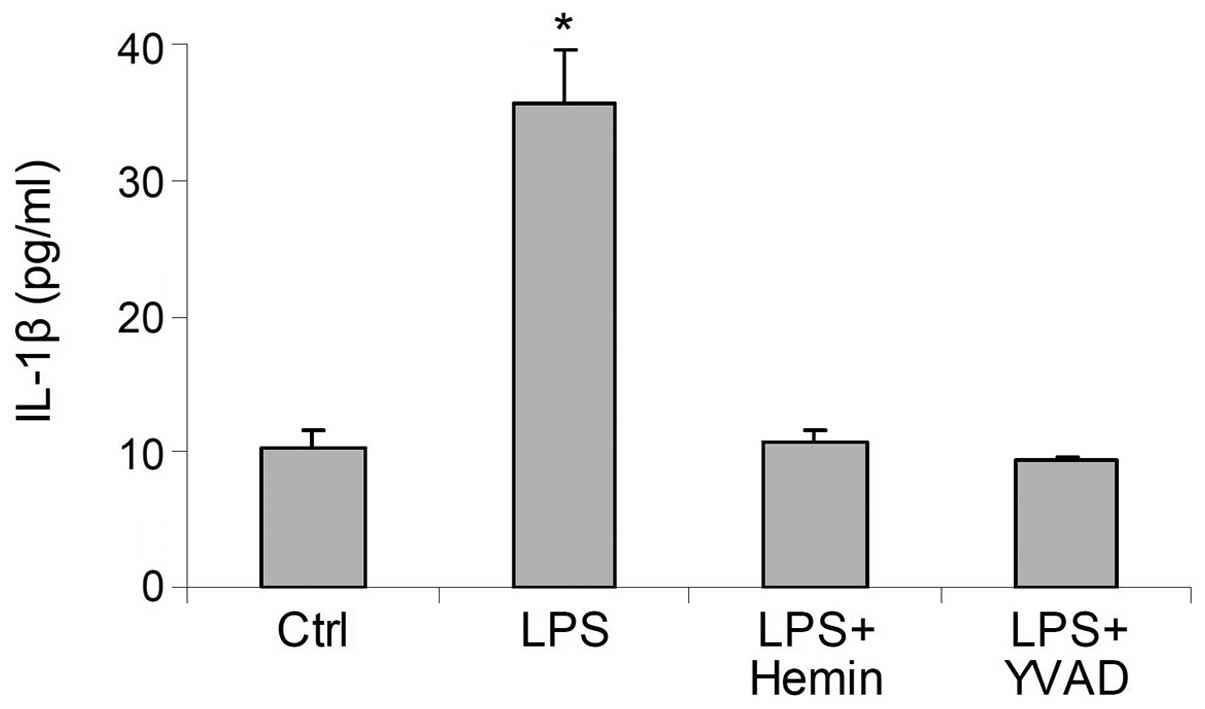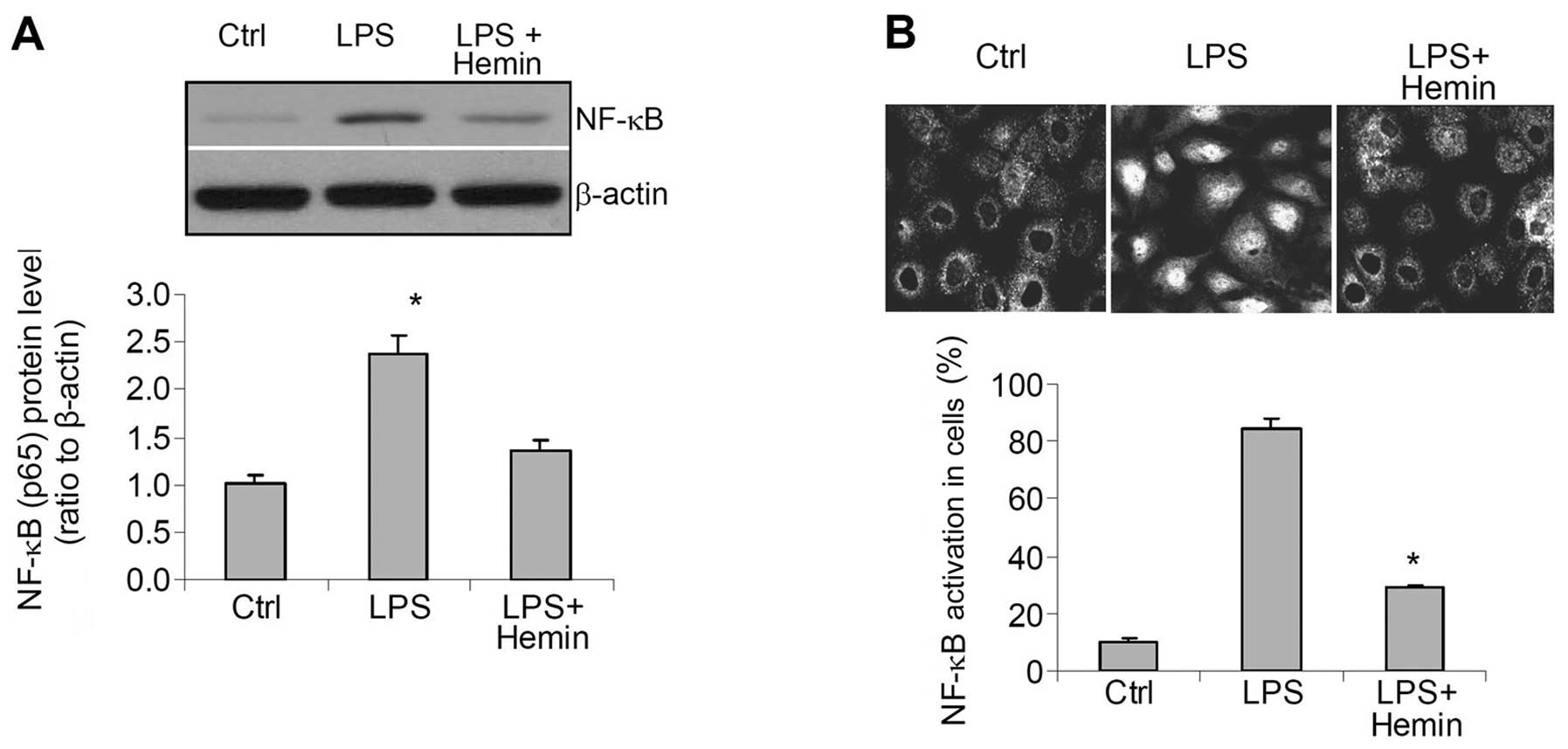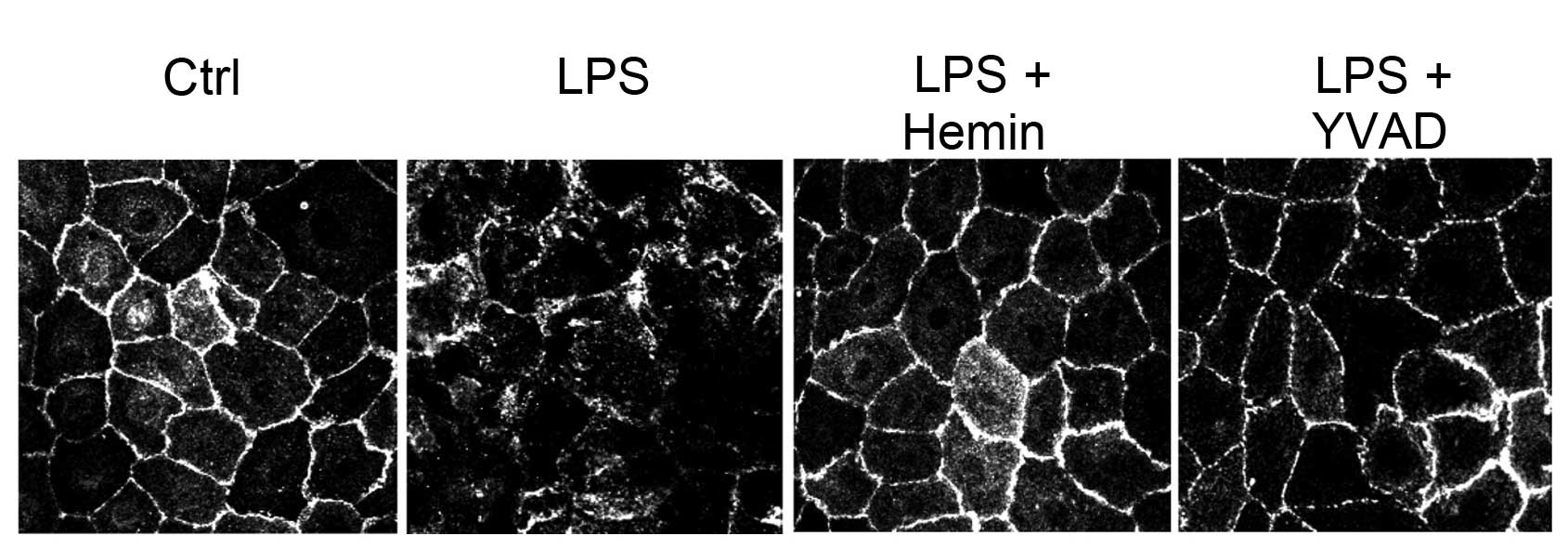Induction of heme oxygenase-1 attenuates lipopolysaccharide-induced inflammasome activation in human gingival epithelial cells
- Authors:
- Published online on: July 25, 2014 https://doi.org/10.3892/ijmm.2014.1865
- Pages: 1039-1044
Abstract
Introduction
Periodontitis, one of the most prevalent chronic diseases, is an infection-associated chronic inflammatory disease of the periodontium and the major cause of tooth loss. Although interleukin-1β (IL-1β) is critical in the host defense against pathogens, it has been shown to be a pathogenic factor for the destruction of periodontal tissue in periodontitis (1,2). The processing of IL-1β is regulated by cytosolic machinery termed as the inflammasome (3,4). The major components of the inflammasome include the NOD-like receptor family, pyrin domain containing protein (NLRP) and apoptosis-associated speck-like protein containing a caspase recruitment domain (ASC), which recruits and activates caspase-1. Activated caspase-1 in turn cleaves pro-IL-1β to produce mature IL-1β. Therefore, the inflammasome plays an important role in the production of IL-1β.
Different inflammasomes, which contain different NLRP family proteins, have been identified, such as NLRP1, NLRP3, and NLRC4. These different inflammasomes are activated in response to different stimuli (5). It has been demonstrated that the NLRP3 inflammasome is the NLR subset inflammasome that is activated in periodontitis (6). It has also been shown that Porphyromonas gingivalis (P. gingivalis) infection activates the NLRP3 inflammasome and increases the production of IL-1β (7–8). Similarly, the bacterial endotoxin, lipopolysaccharide (LPS), can also activate the NLRP3 inflammasome and stimulate the production of IL-1β (8–10). Gingival epithelial cells (GECs) are an important component of the innate host response to periodontal bacteria and make a significant contribution to the gingival health of the host (11). A recent study revealed that the LPS-induced activation of the NLRP3 inflammasome is an important mediator of the inflammatory response in the gingival epithelium (8). Therefore, targeting the inflammasome in the gingival epithelium may be a potential strategy for the prevention and treatment of periodontitis.
Heme oxygenase-1 (HO-1) is an ubiquitous inducible cellular stress protein and an endogenous cytoprotective enzyme (12). HO-1 catalyzes the rate-limiting step in heme degradation, producing equimolar quantities of biliverdin, iron and carbon monoxide. Biliverdin is subsequently converted to bilirubin by biliverdin reductase (13–15). The products of HO-1 exhibit protective biological activities, including antioxidant and anti-inflammatory effects (12). Reactive oxygen species have been shown to activate the inflammasome and antioxidants inhibit the inflammasome (16,17). With a strong antioxidant function, the HO-1 pathway may inhibit the inflammasome. Indeed, although there are very limited reports studying the effect of the HO-1 pathway on the inflammasome, a literature search found two studies showing that the induction of HO-1 inhibited inflammasome activation and reduced the release of IL-1β in acute live failure (18) and lung injury (19). Given the fact that LPS produces oxidative stress and activates the inflammasome (8–10), we hypothesized that the induction of the HO-1 pathway may inhibit the inflammasome and protect against LPS-induced inflammatory damage in human GECs. To examine this hypothesis, we first determined the effects of hemin, a potent HO-1 inducer, on the LPS-induced activation of the inflammasome, then measured the production of IL-1β and the activation of nuclear factor-κB (NF-κB), and finally, assessed the cell damage. To the best of our knowledge, our study is the first to demonstrate that the induction of HO-1 by hemin attenuates inflammatory damage in human GECs through the inhibition of inflammasome activation.
Materials and methods
Cell culture
Human GECs were purchased from Yuhengfeng Biotech (Beijing, China) and cultured according to the manufacturer’s instructions in a defined epithelial cell medium (Yuhengfeng Biotech) supplemented with fetal bovine serum (FBS) (2%), epithelial cell growth supplement (1%), penicillin (100 IU/ml) and streptomycin (100 μg/ml) at 37°C in a humidified atmosphere of 5% CO2 in air.
Cell treatment and experimental groups
The cells were subcultured in 10-cm dishes and treated with the vehicle (0.2% DMSO as a control), LPS (2 μg/ml), LPS plus hemin (20 μmol/l) or Ac-YVAD-CMK (10 μmol/l, a caspase-1 inhibitor) for 16 h when they reached 80% confluence. The cells were then harvested for protein and RNA isolation as described below. Some cells were cultured on glass coverslips for immunofluorescent staining and confocal microscopy as described below.
Preparation of cytosolic protein and nuclear extracts, western blot analyses for the protein levels of HO-1, NLRP3, ASC, caspase-1 and NF-κB (p65), as well as co-immunoprecipitation (Co-IP) of ASC and NLRP3
Cytosolic and nuclear proteins were prepared as previously described (20,21). Briefly, the cells were scraped and washed with phosphate-buffered saline (PBS), and then homogenized in ice-cold HEPES buffer A containing 10 mM HEPES (pH 7.9), 1.5 mM MgCl2, 10 mM KCl, 0.5 mM dithiothreitol (DTT), 0.5 mM phenylmethylsulfonyl fluoride (PMSF) and 10% Nonidet P-40. Following centrifugation of the homogenate at 1,000 × g for 5 min at 4°C, the supernatants were collected for cytosolic protein preparation and the pellets for nuclear protein isolation. The supernatants were centrifuged again at 6,000 × g for 10 min and the resulting supernatants were used as cytosolic proteins for western blot analyses of HO-1, NLRP3, ASC and caspase-1.
For nuclear fraction isolation, the pellets from the first centrifugation, which contains cell nuclei, were washed with buffer A and then incubated with ice-cold HEPES buffer B containing 5 mM HEPES (pH 7.9), 1.5 mM MgCl2, 300 mM NaCl, 400 mM KCl, 0.2 mM EDTA, 0.5 mM DTT, 0.5 mM PMSF and 26% glycerol for 30 min to release nuclear proteins. Subsequently, the reaction mixtures were centrifuged at 23,000 rpm for 30 min, and the supernatant was collected and stored at −80°C until use as nuclear extracts for western blot analyses of NF-κB levels.
Western blot analysis was performed as previously described (22). Briefly, protein samples (20 μg) were subjected to 10% sodium dodecyl sulfate-polyacrylamide gel electrophoresis (SDS-PAGE) and transferred onto nitrocellulose membranes. The membranes were probed with primary antibodies and then horseradish peroxidase-labeled secondary antibodies. Following incubation with enhanced chemiluminescence detection solution (ECL; Pierce, Rockford, IL, USA), the membranes were exposed to Kodak X-OMAT film (VWR International China Co., Ltd., Shanghai, China). The intensity of the blots on the film was determined using an imaging analysis program (ImageJ, free download from http://rsbweb.nih.gov/ij/).
The primary antibodies used in the present study included anti-human HO-1 (1:1,000 dilution), NLRP3 (1:500), ASC (1:1,000), caspase-1 (1:3,000) and NF-κB (p65) (1:1,000), which were from Santa Cruz Biotechnology, Inc. (Dallas, TX, USA, distributor in Shanghai, China).
Co-IP of ASC and NLRP3
Co-IP was performed using a kit from Takara Bio, Inc. (Beijing, China) following the manufacturer’s instructions. In brief, the cell lyses were mixed with antibody against ASC followed by the addition of protein-A beads. The beads were then collected and subjected to western blot analysis with anti-NLRP3 antibody.
Immunofluorescence microscopy
Immunofluorescence staining was performed using the cells cultured on glass coverslips, as previously described (20). Following fixation with 2% paraformaldehyde for 30 min, the cells were incubated with anti-ASC (1:100 dilution), anti-caspase-1 (1:100 dilution), anti-E-cadherin (1:200) and/or anti-NF-κB (1:200) antibodies at 4°C overnight. Following washing, the slides were incubated with corresponding Alexa Fluor 488- or Alexa Fluor 555-labeled secondary antibodies and then subjected to examinations using a confocal laser scanning microscope (FluoView FV1000; Olympus, Tokyo, Japan). The images were analyzed and the co-localization co-efficients were calculated using the computer program, Image-Pro® Plus (Media Cybernetics, Silver Spring, MD, USA), as previously described (23).
RNA extraction and reverse transcription-polymerase chain reaction (RT-PCR) of the mRNA expression of HO-1
Total RNA was extracted using TRIzol reagent (Life Technologies, Inc., Rockville, MD, USA). RNA was then reverse-transcribed and the PCR products were amplified using an RT-PCR kit (Solarbio Science and Technology, Beijing, China) and a thermocycler (Lab-Eye; Chuangmeng Biotechnology, Shanghai, China). The primers used were as follows: HO-1. sense, 5′-GGGTGACAGAAGAGGCTAAGACC-3′ and antisense, 5′-AGATTCTCCCCTGCAGAGAGAAG-3′ (24). The PCR cycling conditions were as follows: 30 cycles of 94°C for 30 sec; 55°C for 30 sec; and 72°C for 45 sec. The amplified products were visualized by 1.5% agarose gel electrophoresis, stained with ethidium bromide and images were captured under ultraviolet light.
Enzyme-linked immunosorbent assay (ELISA) of IL-1β in cell culture medium
The concentration of IL-1β in the cell culture medium was measured using a Valukine ELISA kit (R&D Systems, Shanghai, China) according to the manufacturer’s instructions.
Statistics
Data are presented as the means ± standard error (SE). The significance of differences in mean values within and between multiple groups was evaluated by ANOVA followed by a Tukey’s multiple range test. The Student’s t-test was used to evaluate the statistical significance of differences between 2 groups. A value of P<0.05 was considered to indicate a statistically significant difference.
Results
Effects of hemin on the expression of the inflammasome components, NLRP3, ASC and caspase-1
RT-PCR and western blot analysis of HO-1 mRNA and protein revealed the predicted bands, which confirmed that HO-1 was expressed in the cells used in the present study (Fig. 1A). Treatment of the cells with LPS markedly increased the protein levels of all 3 components of the inflammasome, NLRP3, ASC and caspase-1. However, hemin blocked the increase in the levels of NLRP3, ASC and caspase-1 induced by LPS (Fig. 1B–D). These data suggest that LPS stimulates the expression of inflammasome components and that hemin blocks the LPS-induced activation of the inflammasome.
Effect of hemin on the formation of the inflammasome
LPS markedly increased the immunostaining of caspase-1 and ASC (Fig. 2A), as well as the co-localization of these 2 proteins (Fig. 2B). (Co-IP) assay demonstrated that LPS markedly increased the binding of ASC with NLRP3 (Fig. 2C). The increased co-localization of caspase-1 and ASC, as well as the binding of NLRP3 and ASC were markedly inhibited by hemin (Fig. 2). These results indicated that LPS increased the assembly of inflammasome components and the recruitment of caspase-1, further suggesting that LPS activated the inflammasome and that hemin blocked the LPS-induced activation of the inflammasome.
Effects of hemin on the production of IL-1β
In the LPS-treated cells, the levels of IL-1β were markedly increased; this effect was blocked by hemin (Fig. 3). These results suggested that hemin inhibited the LPS-induced activation of the inflammasome and reduced the production of IL-1β. The inhibitory effects of hemin on the production of IL-1β were similar to those of YVAD, a caspase-1 inhibitor (Fig. 3), further indicating that treatment with hemin resulted in an inhibition of caspase-1 activity through the deactivation of the inflammasome.
Effects of hemin on the activity of the inflammatory factor, NF-κB
Western blot analysis revealed a significant increase in the levels of NF-κB in the nuclear extracts (Fig. 4A). Confocal imaging indicated that NF-κB was mainly located in the cytoplasm of the control cells (Fig. 4B), whereas in the LPS-treated cells, NF-κB was mainly observed in the nucleus, indicating the activation and enhanced nuclear translocation of NF-κB. These increases in the translocation of NF-κB into the nuclei were also blocked in the hemin-treated cells (Fig. 4).
Effects of hemin on cell damage
Confocal imaging revealed a derangement of the immunostaining pattern of the cell junction protein, E-cadherin, in the LPS-treated cells, which was blocked in the hemin-treated cells and in the cells treated with the caspase-1 inhibitor, YVAD, (Fig. 5), suggesting that the inhibition of the activation of the inflammasome and its downstream pro-inflammatory effectors by hemin protected the cells from LPS-induced damage.
Discussion
The present study demonstrated that the induction of HO-1 by hemin suppressed the LPS-induced increase in the expression of inflammasome components (NLRP3, ASC and caspase-1), inhibited the assembly of the NLRP3 inflammasome, and blocked the production of IL-1β, as well as the activation of the pro-inflammatory factor, NF-κB. As a result, hemin attenuated the LPS-induced cell damage in the cultured human GECs. To the best of our knowledge, the results of the present study are the first to suggest that the induction of HO-1 inhibits the activation of the inflammasome and protects human GECs against LPS-induced inflammatory damage.
Epithelial cells are the first line cells in contact with pathogens and danger signals/factors, including bacterial toxins. These cells also act as a physical barrier, protecting other cells, such as fibroblasts and osteoblasts, from exposure to pathogens. We thus selected to use GECs in the present study. We first confirmed the presence of HO-1 in the cells by detecting the mRNA and protein expression of HO-1, which is consistent with previous studies showing that HO-1 is expressed in oral epithelial cells (25,26). Similar to the results of a recent study (8), our results revealed an increased expression of NLRP3 inflammasome components in the GECs following treatment with LPS. Using confocal and Co-IP analyses, we further demonstrated that LPS not only increased the expression of NLRP3 inflammasome components, but also stimulated the assembly/formation of this machinery, further demonstrtating the activation of the NLRP3 inflammasome by LPS. Consequently, the production of IL-1β was increased in the LPS-treated cells. However, the LPS-induced activation of the NLRP3 inflammasome and the production of IL-1β were abolished by hemin, suggesting that the acvitation of HO-1 inhibits NLRP3 inflammasome activation, as well as IL-1β production in GECs.
Although it is well recognized that the induction of HO-1 exerts anti-inflammatory effects, the mechanisms involved have not yet been fully elucidated. The inhibition of inflammasome activation and IL-1β production may present one of the mechanisms through which HO-1 executes anti-inflammatory functions. In the present study, we did not attempt to explore the mechanisms through which the HO-1 pathway inhibits the LPS-induced activation of the NLRP3 inflammasome. In this regard, the antioxidant activities of HO-1 may be accountable for this effect. Oxidative stress has been shown to activate the inflammassome (16,17), and at the same time, the products of HO-1 exhibit antioxidant functions (27). Thus, the mechanisms through which the HO-1 pathway inhibits the inflammasome may possibly be mediated through the antioxidant activities, as LPS has been shown to activate the inflammasome through oxidative stress (9,10).
Since IL-1β has been shown to activate NF-κB (28,29) and IL-1β mediates the LPS-induced activation of NF-κB (10), we also evaluated the effects of hemin on the activation of NF-κB (p65). Our results demonstrated that LPS stimulated the translocation of NF-κB into the nucleus, as shown by the increased staining of NF-κB in the nucleus in the confocal images and the elevated levels of NF-κB in the nuclear extracts by western blot analysis. Hemin blocked the LPS-induced translocation of NF-κB into the nucleus. These data indicate that the activation of the HO-1 pathway blocks the activation of downstream inflammatory factors associated with the inflammasome. Since NF-κB, as a transcription factor, also stimulates IL-1β production (4), we cannot rule out the possibility that hemin directly inhibited the LPS-induced NF-κB activation in addition to its effect on the inflammasome and IL-1β. Nevertheless, our data provide compelling evidence that the activation of the HO-1 pathway inhibits inflammasome activation and thereby blocks the downstream inflammatory response induced by LPS.
The inhibition of LPS-induced pro-inflammatory factors IL-1β and NF-κB by hemin is expected to protect the cell damage. We then observed the immunostaining patter of a cell junction protein E-cadherin, which determines the epithelial integrity. In consistent with previous study (30), our result demonstrated that LPS disrupted cell junction as shown by the derangement of E-cadherin staining pattern. However, hemin blocked LPS-induced disturbance in E-cadherin staining pattern, suggesting that induction of HO-1 protected against LPS-induced inflammatory damage in gingival cells, probably through inhibition of LPS-induced activation of inflammasome.
In conclusion, the present study demonstrates that induction of HO-1 activity by hemin inhibits the LPS-induced activation of the NLRP3 inflammasome, reduces the resulting production of pro-inflammatory factors, and consequently attenuates cell damage. Thus, it can be concluded that the activation of HO-1 protects LPS-induced inflammatory damage in GECs, which may be used as a strategy for the prevention and treatment of chronic periodontitis.
References
|
Bascones A, Noronha S, Gómez M, Mota P, Gonzalez Moles MA and Villarroel Dorrego M: Tissue destruction in periodontitis: bacteria or cytokines fault? Quintessence Int. 36:299–306. 2005.PubMed/NCBI | |
|
Orozco A, Gemmell E, Bickel M and Seymour GJ: Interleukin-1beta, interleukin-12 and interleukin-18 levels in gingival fluid and serum of patients with gingivitis and periodontitis. Oral Microbiol Immunol. 21:256–260. 2006. View Article : Google Scholar : PubMed/NCBI | |
|
Pedra JH, Cassel SL and Sutterwala FS: Sensing pathogens and danger signals by the inflammasome. Curr Opin Immunol. 21:10–16. 2009. View Article : Google Scholar | |
|
Schroder K and Tschopp J: The inflammasomes. Cell. 140:821–832. 2010. View Article : Google Scholar : PubMed/NCBI | |
|
Broz P and Monack DM: Molecular mechanisms of inflammasome activation during microbial infections. Immunol Rev. 243:174–190. 2011. View Article : Google Scholar : PubMed/NCBI | |
|
Bostanci N, Emingil G, Saygan B, et al: Expression and regulation of the NALP3 inflammasome complex in periodontal diseases. Clin Exp Immunol. 157:415–422. 2009. View Article : Google Scholar : PubMed/NCBI | |
|
Park E, Na HS, Song YR, Shin SY, Kim YM and Chung J: Activation of NLRP3 and AIM2 inflammasomes by Porphyromonas gingivalis infection. Infect Immun. 82:112–123. 2014. View Article : Google Scholar : PubMed/NCBI | |
|
Yilmaz O, Sater AA, Yao L, Koutouzis T, Pettengill M and Ojcius DM: ATP-dependent activation of an inflammasome in primary gingival epithelial cells infected by Porphyromonas gingivalis. Cell Microbiol. 12:188–198. 2010. View Article : Google Scholar : PubMed/NCBI | |
|
Hua KF, Chou JC, Lam Y, et al: Polyenylpyrrole derivatives inhibit NLRP3 inflammasome activation and inflammatory mediator expression by reducing reactive oxygen species production and mitogen-activated protein kinase activation. PLoS One. 8:e767542013. View Article : Google Scholar | |
|
Kamo N, Ke B, Ghaffari AA, et al: ASC/caspase-1/IL-1β signaling triggers inflammatory responses by promoting HMGB1 induction in liver ischemia/reperfusion injury. Hepatology. 58:351–362. 2013. | |
|
Yilmaz O: The chronicles of Porphyromonas gingivalis: the microbium, the human oral epithelium and their interplay. Microbiology. 154:2897–2903. 2008. | |
|
Pae HO, Kim EC and Chung HT: Integrative survival response evoked by heme oxygenase-1 and heme metabolites. J Clin Biochem Nutr. 42:197–203. 2008. View Article : Google Scholar : PubMed/NCBI | |
|
Maines MD: The heme oxygenase system: a regulator of second messenger gases. Annu Rev Pharmacol Toxicol. 37:517–554. 1997. View Article : Google Scholar : PubMed/NCBI | |
|
Ndisang JF, Tabien HE and Wang R: Carbon monoxide and hypertension. J Hypertens. 22:1057–1074. 2004. View Article : Google Scholar : PubMed/NCBI | |
|
Abraham NG and Kappas A: Heme oxygenase and the cardiovascular-renal system. Free Radic Biol Med. 39:1–25. 2005. View Article : Google Scholar : PubMed/NCBI | |
|
Villegas LR, Kluck D, Field C, et al: Superoxide dismutase mimetic, MnTE-2-PyP, attenuates chronic hypoxia-induced pulmonary hypertension, pulmonary vascular remodeling, and activation of the NALP3 inflammasome. Antioxid Redox Signal. 18:1753–1764. 2013. View Article : Google Scholar | |
|
Komada T, Usui F, Shirasuna K, et al: ASC in renal collecting duct epithelial cells contributes to inflammation and injury after unilateral ureteral obstruction. Am J Pathol. 184:1287–1298. 2014. View Article : Google Scholar : PubMed/NCBI | |
|
Kim SJ and Lee SM: NLRP3 inflammasome activation in D-galactosamine and lipopolysaccharide-induced acute liver failure: role of heme oxygenase-1. Free Radic Biol Med. 65:997–1004. 2013. View Article : Google Scholar : PubMed/NCBI | |
|
Luo YP, Jiang L, Kang K, et al: Hemin inhibits NLRP3 inflammasome activation in sepsis-induced acute lung injury, involving heme oxygenase-1. Int Immunopharmacol. 20:24–32. 2014. View Article : Google Scholar : PubMed/NCBI | |
|
Han WQ, Zhu Q, Hu J, Li PL, Zhang F and Li N: Hypoxia-inducible factor prolyl-hydroxylase-2 mediates transforming growth factor beta 1-induced epithelial-mesenchymal transition in renal tubular cells. Biochim Biophys Acta. 1833:1454–1462. 2013. View Article : Google Scholar | |
|
Yu X, Deng L, Wang D, et al: Mechanism of TNF-α autocrine effects in hypoxic cardiomyocytes: initiated by hypoxia inducible factor 1α, presented by exosomes. J Mol Cell Cardiol. 53:848–857. 2012. | |
|
Zhu Q, Wang Z, Xia M, Li P-L, Zhang F and Li N: Overexpression of HIF-1α transgene in the renal medulla attenuated salt sensitive hypertension in Dahl S rats. Biochim Biophys Acta. 1822:936–941. 2012. | |
|
Zinchuk V, Zinchuk O and Okada T: Quantitative colocalization analysis of multicolor confocal immunofluorescence microscopy images: pushing pixels to explore biological phenomena. Acta Histochem Cytochem. 40:101–111. 2007. View Article : Google Scholar | |
|
Zhong Y, Liu T, Lai W, Tan Y, Tian D and Guo Z: Heme oxygenase-1-mediated reactive oxygen species reduction is involved in the inhibitory effect of curcumin on lipopolysaccharide-induced monocyte chemoattractant protein-1 production in RAW264.7 macrophages. Mol Med Rep. 7:242–246. 2013. | |
|
Tsai CH, Yang SF, Lee SS and Chang YC: Augmented heme oxygenase-1 expression in areca quid chewing-associated oral submucous fibrosis. Oral Dis. 15:281–286. 2009. View Article : Google Scholar : PubMed/NCBI | |
|
Milward MR, Chapple IL, Wright HJ, Millard JL, Matthews JB and Cooper PR: Differential activation of NF-kappaB and gene expression in oral epithelial cells by periodontal pathogens. Clin Exp Immunol. 148:307–324. 2007. View Article : Google Scholar : PubMed/NCBI | |
|
Haines DD, Lekli I, Teissier P, Bak I and Tosaki A: Role of haeme oxygenase-1 in resolution of oxidative stress-related pathologies: focus on cardiovascular, lung, neurological and kidney disorders. Acta Physiol (Oxf). 204:487–501. 2012. View Article : Google Scholar : PubMed/NCBI | |
|
Tseng HC, Lee IT, Lin CC, et al: IL-1β promotes corneal epithelial cell migration by increasing MMP-9 expression through NF-κB- and AP-1-dependent pathways. PLoS One. 8:e579552013. | |
|
Viñuales C1, Gascón S, Barranquero C, Osada J and Rodríguez-Yoldi MJ: Interleukin-1beta reduces galactose transport in intestinal epithelial cells in a NF-κB and protein kinase C-dependent manner. Vet Immunol Immunopathol. 155:171–181. 2013.PubMed/NCBI | |
|
He D, Su Y, Usatyuk PV, et al: Lysophosphatidic acid enhances pulmonary epithelial barrier integrity and protects endotoxin-induced epithelial barrier disruption and lung injury. J Biol Chem. 284:24123–24132. 2009. View Article : Google Scholar : PubMed/NCBI |



